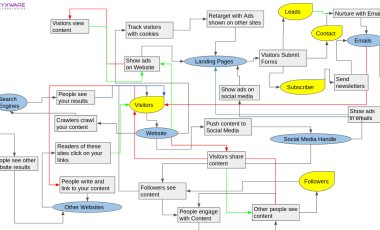Advancing Public Services with Drupal
At the recently concluded he 26th United Nations Climate Change Conference (COP26), CEOs of several lead technology companies like Microsoft, Cisco, Xerox, ServiceNow met together to discuss what they could do to effectively reduce or reverse the harm, industrialisation has done to the environment.
Economic and Environmental Initiatives With Digital Technology At Their Core
While environmentalists like Greta Thunberg reject as incongruous even the notion that industrialists can help, there is truth in the fact that technology leaders have conflicting interests when it comes to effective Environmental initiatives. And though they desire it, their need for business growth and profit surpasses their want for sustainability and climate responsibility. While there might not be an immediate or foreseeable solution they could come up with, they agreed that collaboration and transparency were crucial. Nothing could be achieved by working in silos.
Clare Barclay, CEO of Microsoft UK, said¹,
“Microsoft is a very large company. Everything we do has an impact on others. So we have done a lot of work on the whole of our supply chain, all of our procurement, all of our ordering to make sure that we know what will remove things from our missions and what won’t.
That has been published in a white paper that is publicly available on our website. We’ve taken a stance on being as open and transparent as we can. Collaboration and sharing is the name of the game. Not everyone’s got the right answers, and we feel like the more open and transparent we can be on the things that we’ve learned on everything Microsoft procures is an important basic step forward.”
Every decision we make impacts others. We at Zyxware know that for a fact. That is why Zyxware Technologies is a proponent of free and open-source technology. Our work with a UN agency to advance Sustainable Development Goals for 2030, through digital technologies, is a shining example of leveraging tech to pursue a better world for all humankind.
Drupal & the Non-Profit Sector Go Hand in Glove
Drupal, our preferred digital platform, works well to suit all the needs of a non-profit website. Drupal provides many out-of-the-box functionalities to help manage, collect and disseminate content. While being free and open-source, Drupal has many features that make it best suited for non-profit organisations.
Flexible
Drupal is flexible and can be integrated with other open-source third-party systems.
Secure
Drupal has over one million developers in its community working worldwide, contributing 24x7, calling out and addressing the needed security fixes.
Scalable
Drupal-powered sites can take extreme surges in visitor traffic that is why it is used by Grammy Awards. It works well even under the pressure of load balancing, supercharged databases, and advanced caching.
Responsive
Drupal websites are responsive or device friendly and are useful for multi-channel sites with custom content.
Multilingual
Drupal’s automated language translation allows access to the site content to people from different geographic backgrounds. Drupal also supports languages that have their script running from right to left direction.
Accessibility
Aware of the need for compatibility with the various WCAG (Web Content Accessibility Guidelines) standards, Drupal has various themes that take into account these special needs and comply with them.
These are also some of the reasons why Drupal is used for most UN projects, many government websites, and the weather channel. Almost all Ivy League colleges have Drupal websites. Johnson and Johnson, Pfizer all have thousands of microsites. Some of the well-known non-profit organisations that use Drupal to power their digital endeavours include:
- Amnesty International
- ICRC
- Greenpeace
Open, Transparent, Sustainable Development
The impact of policies and programs in under-developed regions is sketchy to measure, to say the least. When leading charitable organizations like the Bill & Melinda Gates Foundation fund projects to aid development, they truly ensure evaluation and innovation. How 3ie measures this is an interesting case study in itself that you can read here². Sectors of education, poverty eradication, environment and more are positively impacted through this.
No matter the platform or data, when you are committed to deliver true value, perfecting the solution becomes a motivation beyond measure. While the extent to which digital can truly impact public services is still being explored, we are striving to push the boundaries like never before.
Reference Links:
- Derek du Preez, diginomica (online), “COP26 - tech companies grapple with how to navigate climate crisis”, Published 2021-11-08, Link accessed on November 24, 2021
- Nikita, Zyxware (online), “Case Study - How 3ie Uses Evidence Gap Map To Enable Global Development by Directing Scarce Resources to Effective Interventions and Under Researched Areas,” Published 2021-06-28, Link accessed on November 24, 2021.
- Nikita, Zyxware (online), “How Evidence Gap Maps are Transforming Policy-Making and Research Funding in Public Services” Published 2021-06-24, Link accessed on November 24, 2021.
- Nikita, Zyxware (online), “Knowledge Management Hub For An Intergovernmental UN Regional Commission” Published 2021-03-26, Link accessed on November 24, 2021.


